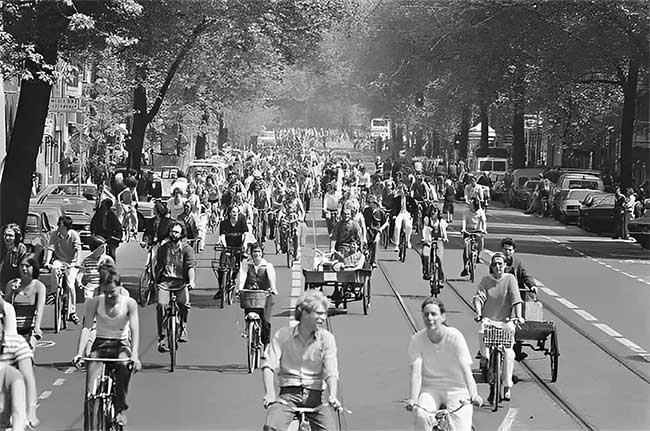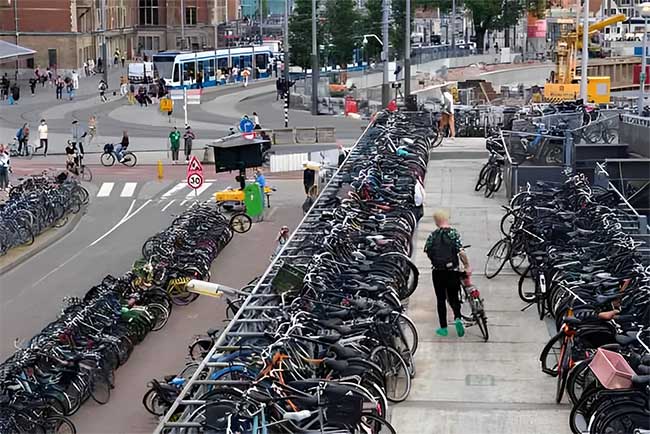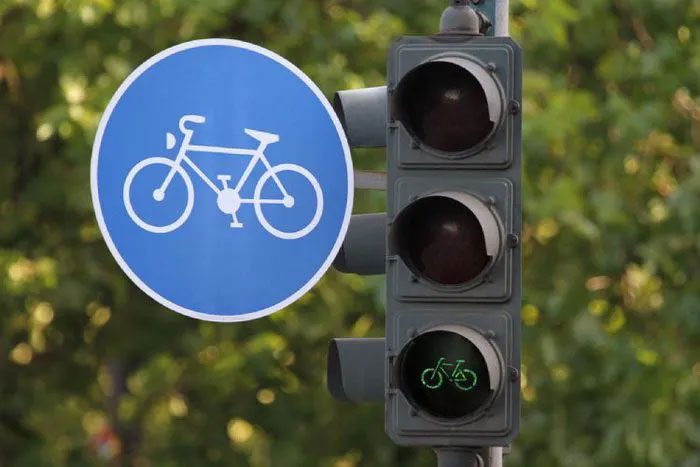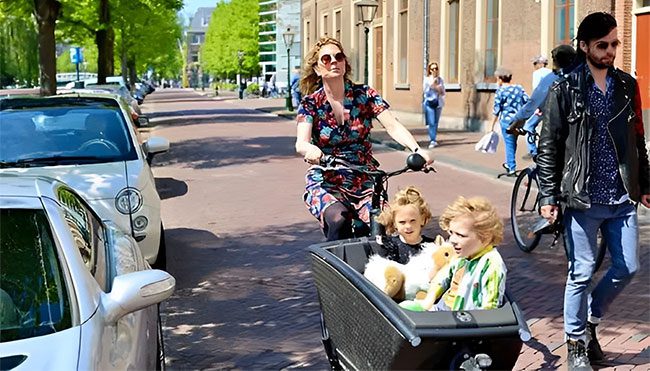The bicycle network in the Netherlands spans nearly 35,000 km, and the country invests approximately 400 million euros annually in bicycle infrastructure.
For the Dutch, cycling is a completely normal activity, an integral part of daily life just like walking. Even the Prime Minister of the Netherlands rides a bike to work. Over the past five decades, the government and the people of the Netherlands have diligently created infrastructure and a culture that supports cycling, overhauling road networks, parking facilities, and traffic laws to facilitate bicycle mobility.
Although in the 1920s and part of the 1930s, the Dutch primarily used bicycles, everything changed dramatically following the two World Wars. The rate of car ownership surged as production costs fell, similar to the trend seen in most developed countries. By the 1970s, at least one in five residents owned a car.
This surge in motorization came at a price. In 1971, over 3,000 people were killed in motor vehicle accidents, including 500 children. One of these children was the daughter of journalist Vic Langenhoff, who wrote the work “Stop de Kindermoord” (“Stop the Child Murder”), sparking massive public protests against traffic accidents.

For the Dutch, cycling is a part of daily life just like walking.
Maartje van Putten, who later became a Member of the European Parliament, chaired the protest and was instrumental in bringing about changes in traffic policy to encourage cycling as a normal means of commuting. Putten’s determination, along with community activists and cycling enthusiasts, led to public policy changes.
Initially, there were mandatory car-free Sundays. Subsequently, there were improvements in urban planning and laws to encourage cycling by providing accessible infrastructure and road safety measures prioritizing cyclists.
The Netherlands: 17 Million People and 23 Million Bicycles
With over 36% of the population using bicycles as their primary mode of transport, on average, the distance that the Dutch travel by bicycle each year is equivalent to travel by train. Only 45% use cars, while the remaining 11% rely on public transport. Bicycle usage is even higher in cities like Groningen at 58%, Zwolle at 46%, and Amsterdam at 38%.
Like most European countries, the road network in the Netherlands is relatively congested, making cycling much easier than driving. The country’s terrain is also quite flat, which facilitates cycling.

A bicycle parking area in the Netherlands.
The Most Comprehensive Cycling Infrastructure in the World
The transportation network in the Netherlands features comprehensive cycling infrastructure. Of the total road network spanning 139,000 km, dedicated bicycle paths account for 35,000 km. Bicycle paths are often made of red asphalt, well-lit, and clearly marked. They are separated by dashed lines to indicate that cars may use that lane or solid lines to indicate that only bicycles are permitted.
While bicycle paths in many countries pose challenges for cyclists at intersections and roundabouts, the Netherlands prioritizes bicycles over motor vehicles. There are dedicated lanes for cyclists and traffic lights specifically for them.

The Netherlands prioritizes bicycles over motor vehicles.
The Dutch often view cars as “the unwanted child” on the road, and several traffic laws have been enacted to discourage their use. For instance, in areas where both cars and bicycles share the road, the speed limit for cars is set at 30 km/h, with speed bumps where necessary. An interesting consequence of this is that cyclists are not required to wear helmets because the government focuses on building safe streets. Roads with a speed limit of 50 km/h will have elevated bike lanes and separate parallel highways.
Long-distance travelers can also bring their bicycles on trains, ferries, and even airplanes, while buses typically require that bicycles be foldable. Parents often use “bakfiets” or “cargo bikes” equipped with child seats and canopies to take their children to school or play.

Parents often use “bakfiets” or “cargo bikes” equipped with child seats.
The city of Utrecht in the Netherlands has the largest bicycle parking facility in the world with three levels of underground space. Located near Utrecht Central Station, the garage can accommodate more than 12,599 bicycles. In 2022, the city of Amsterdam completed a four-year project worth $65 million to encourage cycling by building an underwater bicycle parking facility. Situated at Amsterdam Central Station, the new garage can hold 7,000 bicycles and is set to expand to accommodate 11,000 bicycles.
According to a 2015 study, approximately 6,500 deaths are prevented each year due to the health benefits of cycling. Regular physical activity reduces the risk of lifestyle-related diseases such as diabetes or high blood pressure, increasing the life expectancy of the Dutch by an additional six months. The reduced mortality rate also saves the country $20 billion annually in healthcare economic benefits.





















































